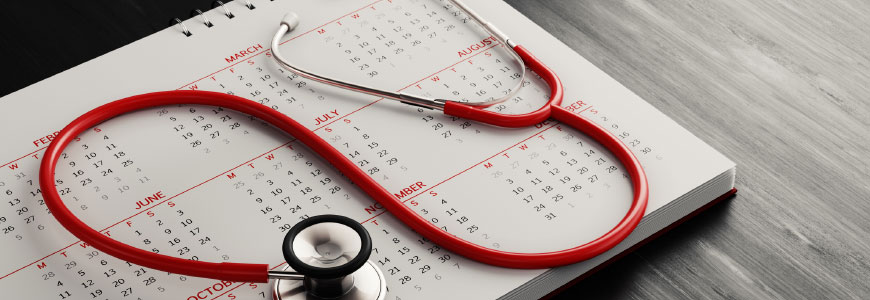Daily scheduling chaos doesn’t have to be a given of patient care. Like a new patient presenting with a plethora of troubling symptoms, your scheduling procedures deserve a thorough once-over. Apply the following diagnostic and treatment skills to your appointment schedule and achieve better outcomes for yourself, your staff, and your patients.
Take a Thorough History
“Use your practice data,” says Andrew Hajde, CMPE, senior industry advisor with Medical Group Management Association (MGMA). What is your no-show rate? Your bump rate? Are certain days of the week worse than others? Then drill down into each category; for example, are no-shows more common among new patients or for a certain type of appointment? Examining as little as two weeks of scheduling data may be enough to give you greater insight into your problems.
Develop a Treatment Plan
Once you’ve diagnosed the problems, brainstorm interventions to address them. Are late arrivals your most common challenge? Develop a communications plan to ensure that patients know your lateness policy. Are no-shows wreaking havoc? Revisit your reminder procedures. (See the “Quick Tips” section below for simple solutions to common problems.) If you find that you have multiple issues, choose one or two to address first. Importantly, it can be helpful to involve the entire practice team in this exercise. Consider this like referring a patient to a specialist—in this case, your administrative staff may be the experts.
Set Realistic Goals
Just as you would with a patient, work with your staff to set achievable goals and reasonable timeframes. Once you know your baseline, use the SMART model to establish new goals that are specific, measurable, achievable, relevant, and time-bound. Let’s say your no-show rate is 20%. Your SMART goal might be to reduce the no-show rate to 15% in three months. Schedule follow-ups to track your progress, celebrate successes, and set the next milestone you want to work toward.
Involve Patients
We’ve all heard of patient-centered care—the same applies to practice management. Don’t assume you know what your patients want or need—ask them. Remember, your scheduling issues affect them as well, and any changes you implement will, too. Hajde shared the story of an orthopaedic practice that’s schedule was continually upended by late patients. After months of frustration, a patient pointed out that there were only two accessible parking spaces near the door—a particular obstacle for patients with wheelchairs, walkers, and crutches. Patients can often provide valuable information about the causes of their no-shows and late arrivals, as well as insight into what changes they’d like to see.
Recognize Scheduling as a Chronic Condition
Scheduling problems are never going to go away completely, but they are manageable. Like many chronic conditions, what is effective today may not work forever. You have to continually monitor results, adapt your interventions, and be ready to try new things.
Quick Tips for Common Problems
No-Shows:
- Use text messaging. Hajde says this is now the new industry standard: “A lot of people don’t read email in a timely manner, there’s so much junk email. But almost everyone reads texts.” Or consider a tiered approach: send an email five days out, call two days before, and send a text the day prior.
- Have a no-show policy, and make sure patients know what it is. Have patients sign the policy as part of registration, and inform them of the policy during scheduling and reminder calls. Consider setting a fee for no-shows, as well—but be sure to carefully document that the patient was informed ahead of time.
- Reconsider return visits. Return visits typically have a high no-show rate. A check-in phone call may be just as effective, and a return visit can be scheduled during the call if the patient has concerns or continuing symptoms.
Late Arrivals:
- Make sure patients are prepared. Ensure that patients, especially new ones, know how to find your office (both the building and your office inside the building) and where to park. If there is construction in the area, let them know. Post directions on your website, and take a look at your signage to make sure you’re easy to find.
- Set expectations. “The more you beat the drum of arriving early, the more likely they are to come on time,” says Hajde. The standard is to ask patients to arrive 15 minutes before their appointment time. As with no-shows, have a written policy and continually reinforce it with patients through new-patient registration paperwork, in-office signage, and mentions during reminders. Hajde says that some practices even provide “What to Expect at Your Appointment” videos on their websites.
Physician Delays:
- Think supply and demand. Remember undergrad Econ 101? In healthcare, supply equals the number of clinical staff hours, and demand is the number of patients needing appointments. The goal is to balance the two. Again, your practice data is invaluable here; figure out which days and times have the highest demand, and schedule your supply accordingly. Hajde also recommends looking for seasonal variations: flu and allergy cycles, regional sports seasons, even seasonal weather conditions that may lead to higher appointment demand. (Compare staff vacation times against these variations, too—you may be surprised by what you learn.)
- Communicate, communicate, communicate. Things happen. When clinical staff members are running late on their schedule, let patients know. Consider a scrolling electronic message board in the waiting room to inform patients as they arrive. If the problem snowballs as the day continues, contact patients to inform them of the delay, and ask if they want to reschedule.
Check out recent practice managment articles:
